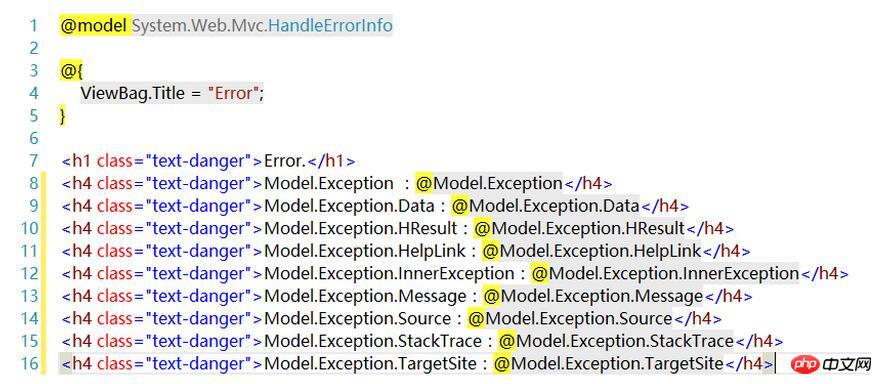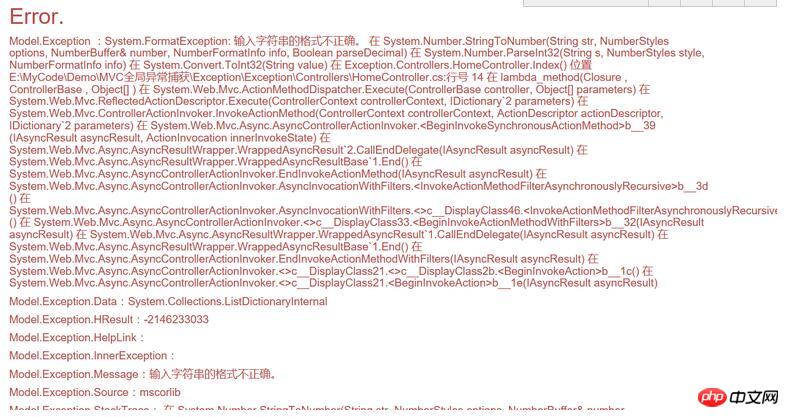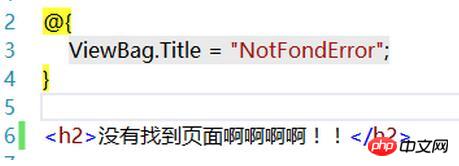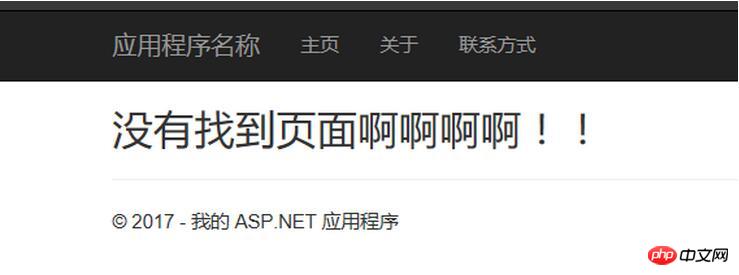Problems and solution examples about MVC exception handling
This article mainly introduces the relevant information of MVCException handling in detail, which has certain reference value. Interested friends can refer to it
In daily development, we will catch a lot of exceptions for processing. Usually our method is to add try catch blocks where exception handling is needed. However, if there are many places where exception handling is needed, then, We will frequently write try catch blocks. For us programmers who are naturally 'lazy', we always want to find a shortcut. Therefore, there will be global exception handling. So, today, we will take a look at how to perform global exception handling in MVC.
1. MVCFrameworkMy own global exception handling
In MVC, the framework has given us a set of global exception handling features. Class HandleErrorAttribute class. We can find such a line of code in the FilterConfig.cs file in the App_Start folder in MVC
public static void RegisterGlobalFilters(GlobalFilterCollection filters)
{
filters.Add(new HandleErrorAttribute());
}This is to instantiate a HandleErrorAttribute class and put it into filter in . Then there is an Error.cshtml page in our Views>Shared folder. The type of Model in this page is System.Web.Mvc.HandleErrorInfo. This is what the MVC framework has already written for me. Yes, we can use it directly.
In the Error.cshtml page, we can do further processing to display error information and display error information according to needs. These error messages will be found in certain properties in the System.Web.Mvc.HandleErrorInfo class.
For example: the following is Error.cshtml.

We deliberately write an exception in Control:
##
public class HomeController : Controller
{
public ActionResult Index()
{
string i = "12a";
int j = Convert.ToInt32(i);
return View();
}
}
The exception handling that comes with MVC defaults to handling exceptions with error codes in the 500 series. If it is 404, this will not be done. However, we can handle it through the settings of the Web.config file. See how we handle it.
First, we complete the Error.cshtml page, add a Control to it, and then write a View and Control specifically to handle 404. As shown belownamespace Exception.Controllers
{
public class SharedController : Controller
{
// GET: Shares
public ActionResult Error()
{
return View();
}
public ActionResult NotFondError()
{
return View();
}
}
}

2. Rewrite exception handling in MVC
In development, we often have such a requirement, we need Record and save exceptions through text logs. Then MVC's own exception handling method System.Web.Mvc.HandleErrorInfo does not have such a function, so we rewrite it to make it have this function. Next, let's look at how to rewrite it. First we build a class, let this classpublic class CustomHandleErrorAttribute : HandleErrorAttribute
{
public override void OnException(ExceptionContext filterContext)
{
base.OnException(filterContext);
var err = filterContext.Exception.Message;//错误内容
//=============================
//将错误记录到日志中
//=============================
}
}public class FilterConfig
{
public static void RegisterGlobalFilters(GlobalFilterCollection filters)
{
filters.Add(new HandleErrorAttribute());
filters.Add(new CustomHandleErrorAttribute());
}
}The above is the detailed content of Problems and solution examples about MVC exception handling. For more information, please follow other related articles on the PHP Chinese website!

Hot AI Tools

Undresser.AI Undress
AI-powered app for creating realistic nude photos

AI Clothes Remover
Online AI tool for removing clothes from photos.

Undress AI Tool
Undress images for free

Clothoff.io
AI clothes remover

AI Hentai Generator
Generate AI Hentai for free.

Hot Article

Hot Tools

Notepad++7.3.1
Easy-to-use and free code editor

SublimeText3 Chinese version
Chinese version, very easy to use

Zend Studio 13.0.1
Powerful PHP integrated development environment

Dreamweaver CS6
Visual web development tools

SublimeText3 Mac version
God-level code editing software (SublimeText3)

Hot Topics
 C++ function exceptions and multithreading: error handling in concurrent environments
May 04, 2024 pm 04:42 PM
C++ function exceptions and multithreading: error handling in concurrent environments
May 04, 2024 pm 04:42 PM
Function exception handling in C++ is particularly important for multi-threaded environments to ensure thread safety and data integrity. The try-catch statement allows you to catch and handle specific types of exceptions when they occur to prevent program crashes or data corruption.
 How does C++ exception handling support custom error handling routines?
Jun 05, 2024 pm 12:13 PM
How does C++ exception handling support custom error handling routines?
Jun 05, 2024 pm 12:13 PM
C++ exception handling allows the creation of custom error handling routines to handle runtime errors by throwing exceptions and catching them using try-catch blocks. 1. Create a custom exception class derived from the exception class and override the what() method; 2. Use the throw keyword to throw an exception; 3. Use the try-catch block to catch exceptions and specify the exception types that can be handled.
 What is the relationship between recursive calls and exception handling in Java functions?
May 03, 2024 pm 06:12 PM
What is the relationship between recursive calls and exception handling in Java functions?
May 03, 2024 pm 06:12 PM
Exception handling in recursive calls: Limiting recursion depth: Preventing stack overflow. Use exception handling: Use try-catch statements to handle exceptions. Tail recursion optimization: avoid stack overflow.
 Exception handling in C++ technology: How to handle exceptions correctly in a multi-threaded environment?
May 09, 2024 pm 12:36 PM
Exception handling in C++ technology: How to handle exceptions correctly in a multi-threaded environment?
May 09, 2024 pm 12:36 PM
In multithreaded C++, exception handling follows the following principles: timeliness, thread safety, and clarity. In practice, you can ensure thread safety of exception handling code by using mutex or atomic variables. Additionally, consider reentrancy, performance, and testing of your exception handling code to ensure it runs safely and efficiently in a multi-threaded environment.
 How to handle exceptions in C++ Lambda expressions?
Jun 03, 2024 pm 03:01 PM
How to handle exceptions in C++ Lambda expressions?
Jun 03, 2024 pm 03:01 PM
Exception handling in C++ Lambda expressions does not have its own scope, and exceptions are not caught by default. To catch exceptions, you can use Lambda expression catching syntax, which allows a Lambda expression to capture a variable within its definition scope, allowing exception handling in a try-catch block.
 Exception handling in Java multi-threaded environment
May 01, 2024 pm 06:45 PM
Exception handling in Java multi-threaded environment
May 01, 2024 pm 06:45 PM
Key points of exception handling in a multi-threaded environment: Catching exceptions: Each thread uses a try-catch block to catch exceptions. Handle exceptions: print error information or perform error handling logic in the catch block. Terminate the thread: When recovery is impossible, call Thread.stop() to terminate the thread. UncaughtExceptionHandler: To handle uncaught exceptions, you need to implement this interface and assign it to the thread. Practical case: exception handling in the thread pool, using UncaughtExceptionHandler to handle uncaught exceptions.
 PHP exception handling: understand system behavior through exception tracking
Jun 05, 2024 pm 07:57 PM
PHP exception handling: understand system behavior through exception tracking
Jun 05, 2024 pm 07:57 PM
PHP exception handling: Understanding system behavior through exception tracking Exceptions are the mechanism used by PHP to handle errors, and exceptions are handled by exception handlers. The exception class Exception represents general exceptions, while the Throwable class represents all exceptions. Use the throw keyword to throw exceptions and use try...catch statements to define exception handlers. In practical cases, exception handling is used to capture and handle DivisionByZeroError that may be thrown by the calculate() function to ensure that the application can fail gracefully when an error occurs.
 How to handle cross-thread C++ exceptions?
Jun 06, 2024 am 10:44 AM
How to handle cross-thread C++ exceptions?
Jun 06, 2024 am 10:44 AM
In multi-threaded C++, exception handling is implemented through the std::promise and std::future mechanisms: use the promise object to record the exception in the thread that throws the exception. Use a future object to check for exceptions in the thread that receives the exception. Practical cases show how to use promises and futures to catch and handle exceptions in different threads.






